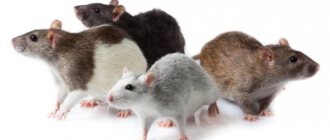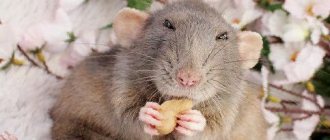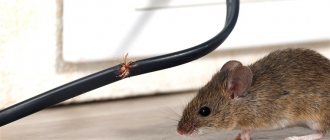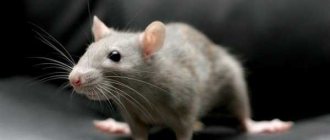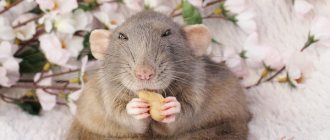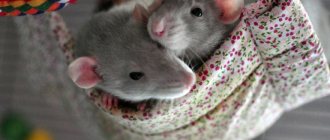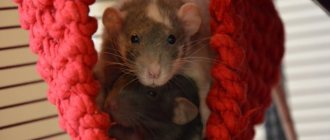Rats can eat any food and are prone to overeating. Therefore, they can quickly gain unhealthy weight. This can lead to serious illness.
If you want your rodent to remain healthy, you need to monitor its weight. It is important to know the standard parameters of rats to determine whether the animal is developing properly and what its health status is.
What determines the size and weight of rats?
The body weight and size of a rodent depends on several factors:
- The species to which the animal belongs. For example, small rats (Rattus exulans) weigh about 70 g and are only 14 cm long. But pasyuks, which are familiar to humans, grow to 20-25 cm and gain a weight of 200-390 g.
- Gender of the rodent. Males, both in nature and among ornamental representatives of this species, are approximately 10-15% larger than females.
- Hereditary data. If the cub's parents are small, then it is unlikely that it will grow into a large rat. This also works in the opposite direction. In large individuals, the appearance of small offspring indicates some kind of pathology or unfavorable factors during the female’s pregnancy.
- Food and living conditions. The ability to obtain adequate nutrition directly affects how much a rat will weigh. If during pregnancy the female does not receive adequate food, the offspring will be more frail. Vitamin and mineral deficiencies during infancy also affect adult size. The animal will be weak and noticeably smaller than its fellows.
- A calm, comfortable environment has a beneficial effect on the weight of animals. A state of constant stress can inhibit development in small rodents.
- Health. The size of an adult rat is directly related to the condition of its body. Of course, it will not become larger than the parameters assigned to it by nature, but excessive thinness and weight loss are direct evidence of an illness in the animal.
Homemade
Measuring the mass of a rodent is simple; just place it on some sensitive scale. Kitchen ones are also suitable. But there are problems with measuring length. The plastic structure allows them to both stretch the body and compress it. The difference in numbers will be colossal.
Grooming
They constantly need to comb their white fur, and they also need to be washed constantly. To comb the rodent, use a toothbrush, and be sure to have a soft one. While combing, you will have to hold the rodent with your thumbs and forefingers.
If you find yellowness in your pet's fur, then this is a reason to worry. It is possible that your rat is sick and is unable to care for itself.
Important! You should not risk the animal's psyche if you decide to clean the fur by washing it in a basin. You can simply wet cotton pads and wipe your pet's fur
After the procedure, you need to wipe the rodent dry.
Place the cage with the animal away from direct sunlight, as white rats are afraid of bright sunlight.
The largest and smallest rats in the wild
Species of rats differ among themselves in their habitat (some prefer to live close to humans, others far away), in size, and taste preferences. People have known some of the representatives of rodents since ancient times, and some they met quite recently.
- The giant Papuan or Bosavi woolly rat does not even have a scientific name yet. It was discovered in 2009 on the island of Papua, which belongs to the territory of New Guinea. It received its temporary name due to the crater of the Bosavi volcano, where it was discovered. Perhaps it can be considered one of the longest rats, since the size of the body reaches 1 meter, plus a tail of about 30 cm.
- Cane rats or bristle pigs are real giants. Despite the body length of 55-60 cm, the weight of females reaches 4-5 kg, and in males it can reach up to 9 kg. They live in equatorial and southern Africa.
- In Russia, the largest breed is the pasyuk or gray rat . Its body length is 17-25 cm, and its weight is 140-390 g.
- The size of the smallest rat found in the wild barely reaches 11–15 cm, weight from 40 to 80 g. The little ones live in New Guinea, the Pacific Islands, and Southeast Asia. In addition to the official name - small , they are also called Pacific or Polynesian .
Children's legends about mutant rodents that appeared due to environmental problems do not have any supporting facts.
Giant rats: myth or reality
Surely each of us has heard creepy stories about giant rats living in abandoned buildings and subways. There are a huge number of articles in newspapers and magazines, and people, reading such stories, believe in it and are really afraid that one day they will meet a mutant rat in person and will definitely take it to their home.
In fact, these are all unconfirmed myths, and the press uses them to attract readers and increase demand for their magazines and newspapers.
The largest rat in Russia is the pasyuk, its size does not exceed the size of an ordinary cat. Of course, their dimensions can be quite impressive, but this is not the result of a mutation, but simply an abundant diet. Pasyuk is definitely not a bloodthirsty monster and does not attack people. Therefore, you shouldn’t believe in mutant rodents, much less be afraid of them.
The largest city rats
City rats are the same animals that live in rural areas. For a long time, black representatives of this family settled in the attics and basements of houses, lurked around the streets and spoiled the supplies of the townspeople, and served as a source of various diseases. In the 18th century, gray rats began to spread from port cities throughout Europe. Larger, aggressive, eating not only grain reserves, but also meat products, they became a disaster.
A big street rat could drag away a chicken, attack a small child, and, driven into a dead end, bravely fought with cats and dogs. Gradually displacing black rats, pasyuks began to spread throughout all the countries where people live. The most important thing for these animals is the availability of water and food. The only place they avoid is heights. It is almost impossible to meet them on the upper floors of skyscrapers. That's why there are still black rats there, which prefer dry attics. The native element for gray rodents is basements, communications, metro lines, sewers.
Wild animal
Any measures to destroy pasyuks only temporarily reduce their colonies. Smart animals with a clearly constructed hierarchy and defined roles within the group never risk the entire flock. They quickly learn to avoid any human traps and can temporarily leave dangerous territory. But as soon as the colony grows, everything will return to normal.
Rodent squad: general characteristics and features
The closest relatives are rabbits and hares, forming the order Lagomorpha.
Features of the structure:
- Teeth. Distinctive features are the long upper and lower pairs of incisors, which do not have roots and grow throughout the animal's life. Elongated incisors are needed for gnawing hard food.
- Dimensions. Most representatives of mammals are small in size: from 5 cm to 50 cm. The exception is the largest representative of the species - the capybara, whose length reaches 130 cm, weight up to 91 kg.
- Skeleton. Features of the skeleton are a stocky build, hind legs longer than the front, and a long tail. The tail of some individuals may be significantly longer than the body.
- Digestion. Due to feeding on rough plant foods, rodents have long intestines. They have a cecum, where food is processed through fermentation.
This type of mammal is not whimsical and does not require special knowledge or skills in care, so rodents are often chosen as pets.
Features of care:
- Housing. It must be remembered that most rodents are active animals. The cage should be spacious and kept clean. Removal of food debris and washing of the sippy cup is carried out daily. Cleaning the floor and cleaning the litter - once a week. Once a month you need to disinfect the cage.
- Dental care. There should always be wooden sticks in the cage so that the pet can grind his teeth, which are constantly growing, on them.
- The washing up. You need to place a container with fine sand in the cage so that the animal can clean its fur.
- Situation. Rodents are shy and sensitive creatures, so housing, if possible, should be located in a secluded place, protected from the hustle and bustle.
The numerous species of rodents make their classification extensive. The rodent order has 5 suborders:
- protein-like;
- mouse-like;
- porcupines;
- spiny-tailed;
- beaver-like
Classification: more about suborders
- Squirrel-like. Members of the suborder include squirrels, chipmunks, marmots, and flying squirrels. They live mainly in forests, have strong muscles of the lower jaw, this allows them to gnaw and break solid food. Most representatives of the suborder are omnivores.
- Mouse-like. You can most often meet representatives of this family in everyday life. These include mice, rats, hamsters, voles, lemmings, jerboas, and muskrats. Most of them are nocturnal and feed on seeds and grains.
- Porcupines. The group includes agouti, porcupines, mole rats, nutria, chinchillas, and capybaras. Most representatives of this class are large species with a heavy, rather awkward physique. They are characterized by modified hair into coarse bristles or needles.
- Spiny-tailed. There are nine species, including spiny-tailed squirrels, Pela spinytails, long-eared spinytails, and Cape striders. These animals got their name because of their tail, which is partially devoid of fur and covered with pointed scales. Some members of this suborder, with the exception of the spiny-tailed squirrels, have flight membranes that allow them to glide.
- Beavers. There are about 100 species from 3 families: beavers, gophers and pouchhoppers. Scientists identified it as a fairly young detachment only in 2005. This class includes large rodents with cheek pouches and strong limbs.
Size and weight of pet rats
Artificially bred decorative rats are increasingly winning the love of humans. Having been born less than 70 years ago, thanks to a strict selection of producers, we managed to obtain affectionate, peace-loving and intelligent animals. Breeders, taking advantage of the rapid emergence of the next generation in these rodents, are excitedly developing new breeds.
Despite the fact that pets are all approximately the same size, there are several species with the largest rats.
- Brown. On average, the animals weigh 500-600 g, but some specimens reach 900 g. Although this cannot be called the norm. It is possible that the rodents are obese. Representatives of this species live only two years.
- Standard. One of the most common breeds. Affectionate and non-aggressive rodents rarely bite despite their very large size for an ornamental rat. They weigh up to 500 g, body length is about 30 cm.
- Dumbo. Representatives of this species were bred in California. Their large protruding ears give their faces a funny expression. The value of a breed representative is determined by the length of the ears. They grow up to 20 cm and gain a weight of about 400 g.
More about huge mutant rats
Yet stories of giant mutant rats in the Moscow metro or abandoned military bunkers remain surprisingly enduring. Their phenomenon is easy to explain: people do not want to put up with the dullness of their everyday lives and are willing to believe in almost any unusual and inexplicable phenomena, even frightening ones. After all, these “horror stories” give hope that the world around is not as ordinary and dull as it seems most of the time, and there is certainly a place in it for some mysteries - including mutant rats.
Simply put, people want to believe in the existence of monster rats, and science fiction writers, horror film directors, and rumor mongers simply exploit these fears to their advantage. As a result, more and more new versions of “facts” and “eyewitness accounts” constantly appear, and the old ones are repeatedly altered and turned into more and more new versions, sometimes completely different from the originals.
For example, the stories allegedly told by Moscow metro drivers are very well known. According to them, in the farthest sections of the tunnels, the headlights of trains occasionally reveal huge rats the size of dogs crossing the tracks. Most of these stories are full of chilling details: in that brief moment that a ray of light snatches a rat from the darkness of the tunnel, the animal manages to look at the driver with evil green (in other versions - red) eyes, and then suddenly news appears that these animals no poison works. It is unknown which of the drivers tried to poison these mutants (just as the names of those who actually saw these animals are not known), but most storytellers consider it their duty to mention such immunity.
Also popular is an allegedly real story that happened to a group of Moscow diggers (specialists involved in the study of caves and artificial underground tunnels). In a sewer under the zoo, this team was attacked by five large rats the size of a dog, and the guys were saved only by throwing their crowbars at the animals and in this way scared them away.
This story was continued. They say that an anonymous person later called the diggers club and said that there were a lot of large rats in secret bunkers for storing radioactive waste. It is well known that the more secrecy and conspiracy theories there are in a story, the more popularity it will have...
There are also stories circulating among people about giant rats climbing out of manholes near landfills and scattering dogs there. Moreover, these stories are unusually tenacious: the first reports of such rats appeared back in 1989, and after that their number has only increased.
It is interesting to note that the less believable each particular story is, the more easily it spreads among the people. It is the details that seem fantastic that make such tales “hot”: either huge rats create the most complex organizations with commanders, pioneers and suicide bombers, or they deliberately feed on poisons or winding wires - there are countless such details.
Someone is even trying to mix together rumors about mutant rats and news about the discovery of Bosavi woolly rats. The result is a mix unimaginable for a specialist that, they say, scientists have discovered a new species of giant rats - Indonesian - in the Moscow subway. Why Indonesian? Simply because the name is simpler than “Bosavi woolly rat” or “Papua New Guinea rat.”
We will not waste time refuting such speculation, but will only say that none of these rumors have factual confirmation.
Average size of baby rats based on their age
Rats are born blind, without fur and with closed ears. Weight at birth is only 4-6 g. Thanks to the mother's nutritious milk, babies grow quickly, adding 2-3 grams every day.
Already on the 10th day of life, they hear well, are covered with fluff, and begin to actively explore the available space. Their body weight increases 6 times during this time.
After 20 days from the moment of birth, rats become similar to adults and grow to a size of about 15 cm.
On the 25th day, the babies are separated from their mother, otherwise the female will independently expel the offspring from the nest into an independent life.
Active growth of young animals continues up to 6 months, but a rat can reach its maximum size only by the age of one year.
Young animals
Approximate weight of the animal depending on age:
- Newborn – 4–6 years.
- 2 months – 160–220 g.
- 3 months – 210–310 g.
- 4 months – 250–430 g.
- 5 months – 300–540 g.
We must not forget that the given indicators are averages, according to which you do not need to adjust your pet. If the animal is active, feels great, and its fur is shiny, then there is no need to try to feed it more high-calorie food or, conversely, limit its food intake.
Should you be afraid of giant rats?
Despite their size, giant breeds of rats are harmless and harmless to people; most individuals feed on fruits, insects, and plant foods. Rodents do not have the goal of attacking humans; moreover, they easily make contact with people and get used to them.
The only time to be wary of rats is when they move in packs. Their flocks consist of more than 100 individuals, which can attack in self-defense. But fortunately, it wasn’t easy to come across a whole pack of rats.
We dealt with the rats. What do you know about spiders? We have selected for you interesting photos and videos about the largest spiders in the world.
How to distinguish an old rat from a young one
As cruel as it may sound, pet store owners view old rats exclusively as stale goods. Therefore, they give sellers the appropriate instructions - at all costs, sell an elderly animal under the guise of a young one. In order not to fall for the tricks of unreliable entrepreneurs, you need to know the main differences between an old rat and a young one:
- Teeth . The tooth enamel of young rats has a yellowish tint, but it darkens with age. And by the age of 2 it becomes dark orange. Moreover, the incisors are much longer than those of young rodents, and the back of the teeth is noticeably ground down. Also, as rats age, they develop dental diseases, which lead to bad breath.
- Fat layer . In aging animals, subcutaneous fat gradually thins out, especially on the back. This feature is manifested by a protruding spine with clearly visible vertebrae. In young healthy animals, the bones are not visible to the naked eye.
- Tail . Young individuals are distinguished by a smooth tail, pleasant to the touch. Old rats' tails are rough, scaly, and easily become dirty and flaky. Also, with age, the pink tails noticeably darken, and in females they sometimes become covered with stripes.
- Wool . The young animals boast beautiful shiny fur, pleasant to the touch and shimmering in the light. The fur of an older rat is coarser, duller, and often ruffled. An aging pet may also experience partial baldness.
- Eyes . Young rats have bright, beady eyes. After one and a half years, the iris brightens, and a characteristic white rim appears around the eye. Rodents may also experience cloudy eyes as they age.
- Porphyrin . The secretion of reddish-brown fluid becomes more active with age. While young animals only occasionally experience moderate discharge from the eyes and nostrils, older animals often walk around with their faces stained with porphyrin.
Additional signs of aging are observed in rats of different breeds. For example:
- Growing Fuzz and Double Rex rats are distinguished by the presence of small balding areas on the face or head. Adults of these varieties have many more balding areas throughout the body.
- Young husky rats have a pronounced mask on their face, as well as a pattern on their body. As they age, their coat gradually becomes lighter. Old husky rats are usually white in color.
- The young animals of the Sphynx breed, although they have small folds, are distinguished by smooth, pleasant-to-touch skin. The skin of aging animals is rougher and wrinkled.
Character can also give away aging rats. Older animals are less active. Instead of playing happily with their relatives or frolicking with toys, they usually sit or lie still. Adults are also characterized by an apathetic mood and slow reactions.
Justified and unfounded fears
In the last century, Moscow newspapers published an article about giant species of rats that were found in the outback of the local metro. They began to crawl to the surface and attack people. The giant rats were similar in size to dogs, had red eyes, yellow plaque on their teeth, and a terrible grin. Large monsters with a terrifying appearance.
With the development of the global Internet, horror stories about rodents increasingly began to appear on the pages of websites. The Chinese presented a photo of the largest rat in the world, holding the huge monster by the tail. The weight of the animal reached several kilograms.
Thanks to such horror stories, people began to have justified and unfounded fears. No one wants to meet a hungry monster with a terrible look on their way. How big can a rat grow? Is there any reason to worry?
What types of rats are there?
It is possible and necessary to think about how many species of rats there are in the world. But it is worth remembering that only some of them can become our neighbors. In total, there are now approximately 70 known species in the rat genus.
The following types of rats are considered ubiquitous on Russian territory (in natural conditions and human habitation):
- Pasyuk (gray);
- black;
- Turkestan (red).
When the question arises, what types of rats may unexpectedly appear in the house, the answer in most cases is representatives of these three species.
By the way, White rats (one of the favorite compact pets) are a type of pasyuki.
Relationships with other animals
Rats are very friendly towards other animals
Decorative rats have a friendly character . They easily get to know other animals and do not show any aggression towards them. In terms of the level of mental and intellectual development, these rodents are equated to cats and dogs. But whether pets become friends depends not only on the rat, but also on the character of the other animal.
How big do rodents grow?
As a rule, a person mainly encounters 2 types of rats in his life - gray and black. Moreover, these representatives of the mouse genus are found almost everywhere: in sewers, in dungeons, in basements, in cellars, in abandoned buildings, in trash cans, etc.
With the onset of cold weather, as well as in conditions of lack of food, rats begin to move closer to humans, appearing in outbuildings for various purposes. Often, rats even attack humans.
Rodents of these species grow up to 25 cm in length, and the length of the tail can be the same. Even the natural size of this animal is impressive, so a number of questions arise. In fact, these rodents never grow to the size of cats, much less dogs. Adult individuals weigh no more than half a kilogram, and such weight is typical for individual individuals. The average size of a rat is no more than 350 grams. Laboratory rats are also not gigantic in size.
It simply does not make sense to breed special types of rats of enormous size, since humans do not eat them. The artificially created breed of white rat weighs no more than 500 grams and does not have an elongated body. If the rat is somewhat large, non-standard in size, then most likely the rat has free access to food and is constantly passing on food.
It is important to know! Rats, like cockroaches, can live without problems in conditions of increased radiation when other living beings cannot survive. Adapting to new conditions, rats begin to mutate. According to observations made in the exclusion zone, the appearance of huge plants, giant vegetables and fruits, cockroaches and rats is possible. Unfortunately, no special research has been carried out, so it is unknown to what size rodents can grow in the exclusion zone, but it is assumed that an increase in size is possible.
The black rat can grow up to 22 cm in length, weighing no more than 300 grams. The white rat is slightly larger in size - its weight is about 500 grams, and its length is about 30 cm.
In countries with warmer climates, larger varieties are found, which differ in that they do not harm humans, while at the same time bringing benefits.
How big are sewer rats and are there giant mutants among them?
In Russia, two types of rats live next to people, in attics, basements and in the sewers of their houses - gray (pasyuk) and black. They are similar to each other, but the gray one is larger: the body length of adult individuals of this species can reach 25 cm (excluding the length of the tail), and the weight is 400 grams. However, gray rats usually do not grow even to the size of a cat.
The photo below shows a gray rat:
And here it is black:
Black rats are smaller than gray ones: the largest individuals of this species reach a length of 22 cm from the tip of the nose to the base of the tail, and their weight rarely reaches 300 grams.
Pasyuk, the larger one, is exactly that sewer rat that willingly inhabits sewers, damp basements and basement floors. The black rat prefers to live in dry rooms and attics. Other types of rats have never been discovered in the Russian urban jungle, and stories that huge rats the size of dogs live in the Moscow metro are so far just unconfirmed rumors (however, we’ll talk about huge “mutant rats” a little lower ).
And in general, the biggest rat in Russia is still the same pasyuk. The fact is that all representatives of the rat genus are heat-loving; in temperate or cold climates they can only live next to humans. In the wild in the south of our country, only black rats live, which are inferior in size to gray ones, and larger species are known only from tropical regions. That is, even in the Siberian wilderness or in the endless steppes of southern Russia, huge rats are not found.

